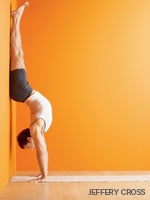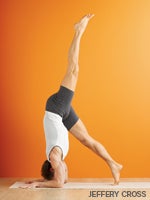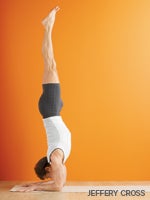Heading out the door? Read this article on the new Outside+ app available now on iOS devices for members! Download the app.
The most common stretch when we wake in the morning is to raise both arms upward and outward, take a deep breath, and yawn. Both humans and animals do it with full abandon. What you are doing instinctually is stretching the sides of your body to inspire a deep and satisfying breath. It feels as though every cell of your body joins together, breathes, and says, “YES! I am awake!”
Practicing Utthita Parsvakonasana (Extended Side Angle Pose) can give you the same energized feeling. The pose teaches you how to stabilize your legs while you open and expand the sides of your rib cage, training the muscles that support good breathing. It also tones the muscles that run along the sides of your body, from the outer heel to the outer hip, along the torso, and up to the outer arm. Developing this strength gives you the structural support you need to lift and lengthen your spine. For this reason, Side Angle Pose is a fundamental pose to practice regularly.
Your aim in Side Angle Pose is to engage your muscles fully to create a single extension from the outer heel of the straight leg all the way to the fingertips of the arm overhead. There are three stages to the pose. First, you establish the foundation in your legs. Then you focus on stretching the arms to expand the chest. Finally, as you bring your top arm over your ear, you rotate the belly and chest up while maintaining the broadness you created in the chest.
The word utthita, to extend, describes how you set up the legs and arms in this pose. I encourage students to pay as much attention to widening their stance as they do to extending their arms. Step your legs wide apart and check that your ankles are below the wrists of your extended arms. Then begin bending one leg toward a 90-degree angle. Walk the foot of the straight leg farther out until the thigh of the bent leg comes parallel to the floor. (Check that your knee is pointing in the same direction as your toes.)
Don’t stop halfway. Bending the leg to 90 degrees helps distribute the effort equally between both legs instead of making your bent leg quadriceps muscles do all the work. (If you get fatigued, come out of it to rest and then try again.) As you bend one leg, extend the other, keeping your knee firm. These dual actions lengthen the inner thighs and stretch the gluteal muscles while strengthening the outer leg muscles and stabilizing the hips.
By establishing firm legs and hips, you allow the front of the pelvis and abdomen to broaden, creating space for the torso to turn open in the full expression of the pose. Prepare for this opening by pressing your supporting hand to the floor or a block and fully extending the elbow. Then, as you extend your top arm upward, you will be able to feel an opening across the collarbones and chest.
Now you’re ready for the final phase of the pose. Move the shoulder blades in toward the chest and keep the chest open as you turn it up toward the arm. Keep the legs and arms rigorous and attentive. When you reach your top arm overhead, press down through your outer heel and foot, and then reach even further through your arm and hand.
Notice how the sides of the torso benefit from this single extension from your outer heel to your fingertips. The oblique muscles become firm while the rib cage softens and widens to let in a deeper, more satisfying breath. In Side Angle Pose, wake up to the limitless energy of your breath and enjoy the expressive, dynamic qualities of a focused body and mind.
Focus Your Mind
When you practice Side Angle Pose, all parts of the body are involved, from feet to fingers, to the front of the torso and to the back and sides. By learning to focus on the many details of the pose simultaneously, you not only achieve a single extension through the side body, but you also train your mind to have a single focus. Practicing in this way can enhance your ability to concentrate and reach for your goals.
Step 1: Virabhadrasana II (Warrior II)
Practice working both legs evenly in Warrior II.
Set It Up:

1. Starting in Tadasana (Mountain Pose), jump your legs wide apart.
2. Extend the arms into a T position with your palms facing down.
3. Turn the right foot outward to 90 degrees, and turn the left foot slightly inward.
4. Lift through your spine, keeping the sides of the torso equally long.
5. Press the left outer foot and heel to the floor as you begin to bend the right knee toward a 90-degree angle.
Refine: To form a right angle with the bent leg, move your left foot away from the right until the right thigh is parallel to the floor and the right shin is perpendicular to the floor. Spend time adjusting the stance in your legs to practice the strong foundation you will need for Side Angle Pose. While you bend the front leg, put equal attention to extending and stretching the back leg.
Finish: Firm the muscles of the arms and fully extend them from the chest out to the fingertips as if they were getting pulled in opposite directions. Keep the torso upright, rather than letting it shift forward over the front leg. Continue to lengthen the spine, moving the back ribs inward as you lift the sides of the torso from the waist to the armpits. Keep your head lifted and upright, not tilting to the right or left.
Step 2: Utthita Parsvakonasana (Extended Side Angle Pose), with a block
Practice with support to learn to spread the arms and expand the chest.
Set It Up:

1. Begin as you did in step 1.
2. Press the left outer foot and heel to the floor as you bend the right leg at the knee to form a 90-degree angle.
3. Bring the right hand to the floor on fingertips, or place your hand on a block.
4. Move the right armpit close to the outer right knee so the arm and shin are parallel.
5. Reach the left arm up toward the ceiling.
Refine: Press the outer right knee back against the arm, and move your right buttock forward. Keep actively extending the left leg. Press the outer left foot and heel down, and lift the inner thigh, inner knee, and arch of the left foot. Reach the left arm toward the ceiling, directly in line with the right arm. Don’t allow your torso to drop toward the floor. Inhale, and widen the chest. Exhale, and turn the chest and abdomen toward the ceiling.
Finish: Move the back ribs and spine in toward the front body, and let the chest expand against the support of the back. Stretch the whole back of the body as you open the chest. If you are able to turn your torso easily, then you can also turn the head and look toward the left thumb.
Final Pose: Utthita Parsvakonasana (Extended Side Angle Pose)
Set It Up:

1. Bring your right hand to the floor or a block.
2. Extend the left arm up toward the ceiling.
3. Turn your chest and abdomen toward the raised arm.
4. Turn your head to look past the left thumb.
Refine: Lift the arches of your feet and maintain a steady pressure on the balls of the feet and the heels, keeping the left outer heel on the floor. Press down into your right hand and reach out through your left arm. Begin to turn your torso and arm simultaneously as one unit, turning the entire arm from the armpit to reach it over your head in line with your ear.
Finish: Move the right buttock and right shoulder blade inward. As you press the left heel, reach toward the left hand until the entire side body has a single and complete stretch. Every layer of the body can be stretched. Feel the skin stretching. Breathe freely in the pose. Inhale to come up, and change sides.
Optimize Your Pose
Explore these modifications of Side Angle Pose:
- Stretch the inner thigh: As you bend the knee, reach the inner thigh toward the knee. Bend and straighten several times without gripping the quads.
- Engage the feet: Place the outer heel of the straight leg against a wall while you practice to help you press down through the outer foot.
- Relieve pressure on the bent leg: Place your hand on a block, and firm the arm to support the weight of the torso.
- Open the chest: Keep the upper hand on the waist in Variation 2. Roll the shoulders back, broaden the collarbones, and turn the chest open.
Elements of Practice
When your breath is shallow, you may feel you are living in a small space, in a body that’s compacted or narrow. This sensation can also affect your mind, creating rigidity in your thinking and behavior. Yoga teaches you to align your body to be vertical and upright. But it’s equally important to expand horizontally so that your awareness can move from the inner space toward the vast universal space. A simple side stretch or a yawn during the day can refresh your breath and expand your sense of self. When you open horizontally, you feel more spacious, and the inside and outside—the Self and the other—no longer feel so separate.
Watch a video demonstration of this pose.
Nikki Costello is a certified Iyengar Yoga teacher.